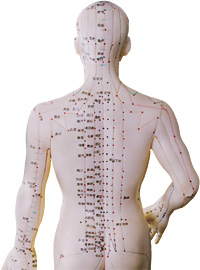Acupuncture

Demystifying Acupuncture
A growing number of patients choose acupuncture as one of their first health-care options
Acupuncture has been practiced in China for over 3,000 years. For most of that time, the Western world was unaware of the significant health benefits associated with this ancient healing modality. But all that has changed over the last few decades as traditional Chinese medicine has become increasingly accepted in the West. Today, a growing number of patients choose acupuncture as one of their first health-care options.
Many Western practitioners use acupuncture primarily for pain treatment, but it can also be highly effective in the treatment of a wide range of other acute and chronic conditions, including digestive disorders and immune system imbalances. Traditional acupuncture works at a basic energy level by balancing its flow within the body. The Qi, or ‘life force’ energy, runs along meridians or channels that comprise the body’s energy distribution system.

Each internal organ or organ system in the body is related to a specific channel. When the energy in a particular channel flows smoothly, the associated organ or organ system is also balanced. If anything occurs to weaken or block this energy flow, the result will be an energetic imbalance that, in turn, manifests itself as illness or disease.
By using acupuncture to correct this energy imbalance, normal bodily functioning can be restored and the healing process can begin. Acupuncture points are specific locations on the body where the Qi can be accessed. Their locations have been mapped and verified over thousands of years of practice. To achieve a more powerful healing effect, acupuncture is commonly used in conjunction with Chinese herbs, the other major therapy practiced in traditional Chinese medicine.
A typical acupuncture session begins with a traditional Chinese medical diagnosis that can take anywhere from 30 minutes to one hour to complete. It usually includes a review of the patient’s physical symptoms, an evaluation of the patient’s physical appearance and demeanor, an assessment of diet and lifestyle, and, most importantly, observations of the pulse and tongue. This protocol enables the acupuncturist to identify the disharmony or imbalance, and then to formulate an appropriate treatment strategy.
When receiving acupuncture, the patient generally lies on their back, front or side, depending on which part of the body is being treated. In some cases, it may be necessary to sit in a chair. Based on the diagnosis, the practitioner selects the appropriate acupuncture points where the needles will be inserted.
All practitioners should use sterilized, disposable acupuncture needles. The needles come in varying lengths and most are not much thicker than a human hair. The choice of needle size is based on clinical judgement, and usually governed by the point being treated and the response the practitioner is seeking.
After locating the appropriate acupuncture point on the body, the practitioner sterilizes the site with alcohol and gently inserts the needle. There may be a slight pinprick as the needle penetrates the skin, but once through, the needle can be moved without discomfort.
When the Qi is accessed, the sensation can vary widely. Initially, the patient may feel a tingling or numb sensation around the acupuncture point, which, in some cases, may travel along the channel. This is usually followed by a dull, heavy or achy feeling around the needle that may last for a few moments or the entire session. To help establish or maintain good contact with the Qi, the needles may be gently manipulated with slight rotating, flicking or rubbing motions.
Depending on the acupuncture point and the condition being treated, the needles may be inserted either on the in-breath or the out-breath. Needles are inserted during the in-breath when treating conditions where the Qi is excessive, such as acute pain or inflammation. In this case, the goal of the acupuncture is to sedate or reduce the Qi in the particular channel or system being affected. In contrast, needles are inserted during the out-breath when treating conditions where the Qi is deficient, such as immune system weaknesses. When treating deficient conditions, the goal of the acupuncture is to build up the Qi in the affected channel or system. Most patients tend to exhibit a combination of symptoms that include both excessive and deficient conditions.
Traditional acupuncture treatments are commonly combined with moxabustion, a process during which “moxa,” a dried herb, usually mugwort, is burned above specific acupuncture points. Moxa provides a penetrating heat that enters the acupuncture point to stimulate the Qi, to increase circulation at the site, and to nourish the body. In the West, the most common form of moxa utilizes a cigar-shaped stick that is lit and rotated around the acupuncture point. The heat not only warms the skin in the immediate area, but is also drawn deep into the channel through the acupuncture needle to support and enhance the treatment.
A typical acupuncture session may last anywhere from 30-60 minutes. The most common reaction following a treatment is a feeling of fatigue, though the patient is usually calm and relaxed. Improvements in chronic conditions are, in general, gradually seen over a course of treatments, while more immediate and dramatic results can occur with acute conditions. Progress is discussed between the patient and practitioner on a regular basis, and frequent diagnostic check-ups help the practitioner adjust the treatments to changes in the patient’s condition. As the condition improves, the frequency of visits is gradually reduced until the treatment program is concluded. However, the total number of treatments required, and the rate of progress, depends on the individual patient.
As with any form of therapeutic treatment, selecting the right practitioner is an important decision. Look for fully registered acupuncturists trained in the practice of traditional Chinese medicine. A well-trained practitioner will explain all the steps in an acupuncture session prior to their being performed, so that the patient fully understands the process and is aware of the various sensations he or she may experience.
In addition, one of the most important aspects of acupuncture is an open and trusting relationship between the practitioner and the patient. Because treatment programs are developed in consultation with the patient, and usually consist of a series of treatments spread over several days or weeks, choosing a practitioner that you trust and feel comfortable with is important. It is equally essential for the patient to provide constant feedback to the practitioner so the treatment can be adjusted or modified to meet the individual needs of each patient. This open dialogue also allows the practitioner to provide emotional support to those patients that need it.
Acupuncture is highly effective for bringing the body back into balance and for stimulating the body’s own healing mechanisms, but it also plays another role in the healing process by helping patients become more aware of their bodies. As patients become more in tune with their own bodies, it becomes easier to detect an imbalance or dysfunction, even in the early stages of development. In this sense, acupuncture is not only useful for treating established illness or disease, but is also a valuable tool in preventive health care.
~ By Dr. Fei Yang
